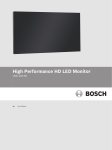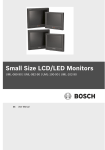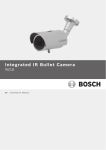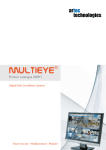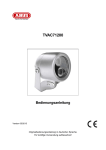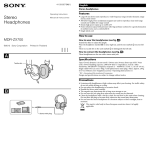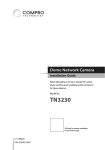Download Bosch Appliances GVS1000 Security Camera User Manual
Transcript
Global View Station 1000 GVS1000 en Operations Manual Global View Station 1000 Table of Contents | en 3 Table of Contents 1 Safety 5 1.1 Important safety instructions 5 1.2 Safety precautions 7 1.3 Important notices 1.4 Customer Support and Service 11 2 Standard Operations 12 2.1 Pan/Tilt 12 2.2 Zoom and Focus Control 12 2.3 Presets 12 2.4 Soft Limits 13 2.5 Preset Tours 13 2.6 Auxiliary Functions 14 3 Code Translator Unit 17 3.1 Pelco Support 17 3.2 Biphase Support 18 4 Camera Default Configuration 19 5 Troubleshooting 22 5.1 General 22 5.2 Troubleshooting with Diagnostic Mode 23 6 Test Software 24 6.1 PTCR-20 Software Operation 24 6.1.1 Default Parameters 26 6.1.2 Using PTCR-20 to Set Soft Limits and Camera Control 26 6.1.3 Inverting Tilt Controls 28 6.1.4 Other Menus 28 6.2 Auxiliary Control Board 29 6.2.1 Reset Button 30 6.2.2 Address Selection 30 6.2.3 Protocol Selection 30 6.2.4 System Communication 30 6.2.5 Self Test Diagnostic Function 30 6.2.6 Termination Jumpers 30 6.2.7 Photocell Control Adjustments 30 6.3 Auxiliary Controls 31 6.3.1 Aux 1 2x Doubler Function 31 6.3.2 Aux 2 Wiper Function 31 6.3.3 Aux 3 Illuminator Control 31 6.3.4 Aux 4 Iris Control 31 6.3.5 Aux 5 Lens IR Correction Mode 31 6.3.6 Aux 6 Camera Color/Mono Mode 31 Bosch Security Systems, Inc. 7 Operations Manual F.01U.173.867 | 2.0 | 2010.11 4 en | Table of Contents Global View Station 1000 6.3.7 Aux 7 ZX700 IR On/Off Control 31 6.3.8 Aux 8 SLED IR On/Off Control 31 6.4 Voltage Touch Points 32 6.4.1 T3 SLED Power Input Indicator 32 6.4.2 T4 Auxiliary Control Power Indicator 32 6.4.3 T5 ZX700 Illuminator Output 32 6.4.4 T6 SLED #1 Power Output Indicator 32 6.4.5 T7 SLED #2 Power Output Indicator 32 6.5 Camera Control Board 33 6.5.1 Reset Button 34 6.5.2 System Communication 34 6.5.3 Camera Control Power Indicator 34 6.5.4 Address Selection 34 6.5.5 Protocol Selection 34 6.5.6 Termination Jumpers 34 6.6 Auxiliary Controls 35 6.6.1 Aux 1 2x Doubler Function 35 6.6.2 Aux 2 Wiper Function 35 6.6.3 Aux 3 Illuminator Control 35 6.6.4 Aux 4 Iris Control 35 6.6.5 Aux 5 Lens IR Correction Mode 35 6.6.6 Aux 6 Camera Color/Mono Mode 35 6.6.7 Aux 7 ZX700 IR On/Off Control 35 6.6.8 Aux 8 SLED IR On/Off Control 35 F.01U.173.867 | 2.0 | 2010.11 Operations Manual Bosch Security Systems, Inc. Global View Station 1000 Safety | en 1 Safety 1.1 Important safety instructions 5 DANGER! The Lightening Flash with arrowhead symbol within an equilateral triangle indicates the presence of uninsulated dangerous voltages within the product enclosure that may be sufficient magnitude to constitute a risk of shock. WARNING! The exclamation point within an equilateral triangle alerts the user to the presence of important operation and maintenance (servicing) instructions in the literature accompanying the product. CAUTION! This grounding symbol indicates the safety ground of the unit. WARNING! TO REDUCE THE RISK OF FIRE OR ELECTRIC SHOCK, DO NOT EXPOSE THIS APPARATUS TO RAIN OR MOISTURE AND OBJECTS FILLED WITH LIQUIDS, SUCH AS VASES, SHOULD NOT BE PLACED ON THIS APPARATUS. TO COMPLETELY DISCONNECT THIS APPARATUS FROM THE AC MAINS, DISCONNECT THIS POWER SUPPLY CORD PLUG FROM THE AC RECEPTACLE. THE MAINS PLUG OF THE POWER SUPPLY CORD SHALL REMAIN READILY ACCESSIBLE. A CLASS 1 APPARATUS SHALL BE CONNECTED TO A MAINS SOCKET OUTLET WITH A PROTECTIVE EARTHING CONNECTION Bosch Security Systems, Inc. Operations Manual F.01U.173.867 | 2.0 | 2010.11 6 en | Safety Global View Station 1000 1. Read these instructions. 2. Keep this instruction. 3. Heed all warnings. 4. Follow all instructions. 5. Do not use this apparatus near water. 6. Clean only with dry cloth. 7. Do not block any ventilation openings. Install in accordance with manufacturer instructions. 8. Do not install near any heat sources such as radiators, heat registers, stoves or other apparatus (including amplifiers) that produce heat. 9. Do not defeat the safety purpose of the polarized or grounding-type plug. A polarized plug has two blades with one wider than the other. A grounding type plug has two blades and a third grounding prong. The wide blade or the third prong is provided for your safety. If the provided plug does not fit into your outlet, consult an electrician for replacement of the obsolete outlet. 10. Protect the power cord from being walked on or pinched particularly at plugs, convenience receptacles, and the power where they exit from the apparatus. 11. Only use attachments/accessories specified by the manufacturer. 12. Use only with the cart, stand, tripod, bracket, or table specified by the manufacturer, or sold with the apparatus. When a cart is used, use caution when moving the cart/ apparatus combination to avoid injury from tip-over. 13. Unplug this apparatus during lightning storms or when unused for long periods of time. 14. Refer all servicing to qualified service personnel. Servicing is required when the apparatus has been damaged in a way, such as power-supply cord or plug is damaged, liquid has been spilled or objects have fallen into the apparatus, the apparatus has been exposed to rain or moisture, does not operate normally, or has been dropped. F.01U.173.867 | 2.0 | 2010.11 Operations Manual Bosch Security Systems, Inc. Global View Station 1000 Safety | en 1.2 Safety precautions 1.3 Important notices 7 Accessories - Do not place this unit on an unstable stand, tripod, bracket, or mount. The unit may fall, causing serious injury and/or serious damage to the unit. Use only with the cart, stand, tripod, bracket, or table specified by the manufacturer. When a cart is used, use caution and care when moving the cart/apparatus combination to avoid injury from tip-over. Quick stops, excessive force, or uneven surfaces may cause the cart/unit combination to overturn. Mount the unit per the manufacturer's instructions. All-pole power switch - Incorporate an all-pole power switch, with a contact separation of at least 3 mm in each pole, into the electrical installation of the building. If it is needed to open the housing for servicing and/or other activities, use this all-pole switch as the main disconnect device for switching off the voltage to the unit. Camera grounding - For mounting the camera in potentially damp environments, ensure to ground the system using the ground connection of the power supply connector (see section: Connecting external power supply). Camera lens - An assembled camera lens in the outdoor housing must comply and be tested in accordance with UL/IEC60950. Any output or signal lines from the camera must be SELV or Limited Power Source. For safety reasons the environmental specification of the camera lens assembly must be within the environmental specification of -10 °C (14 °F) to 50 °C (122 °F). Camera signal - Protect the cable with a primary protector if the camera signal is beyond 140 feet, in accordance with NEC800 (CEC Section 60). Coax grounding: – – Ground the cable system if connecting an outside cable system to the unit. Connect outdoor equipment to the unit's inputs only after this unit has had its grounding plug connected to a grounded outlet or its ground terminal is properly connected to a ground source. – Disconnect the unit's input connectors from outdoor equipment before disconnecting the grounding plug or grounding terminal. – Follow proper safety precautions such as grounding for any outdoor device connected to this unit. U.S.A. models only - Section 810 of the National Electrical Code, ANSI/NFPA No.70, provides information regarding proper grounding of the mount and supporting structure, grounding of the coax to a discharge unit, size of grounding conductors, location of discharge unit, connection to grounding electrodes, and requirements for the grounding electrode. Disposal - Your Bosch product was developed and manufactured with high-quality material and components that can be recycled and reused. This symbol means that electronic and electrical appliances, which have reached the end of their working life, must be collected and disposed of separately from household waste material. Separate collecting systems are usually in place for disused electronic and electrical products. Please dispose of these units at an environmentally compatible recycling facility, per European Directive 2002/96/EC. Electronic Surveillance - This device is intended for use in public areas only. U.S. federal law strictly prohibits surreptitious recording of oral communications. Environmental statement - Bosch has a strong commitment towards the environment. This unit has been designed to respect the environment as much as possible. Bosch Security Systems, Inc. Operations Manual F.01U.173.867 | 2.0 | 2010.11 8 en | Safety Global View Station 1000 Electrostatic-sensitive device - Use proper CMOS/MOS-FET handling precautions to avoid electrostatic discharge. NOTE: Wear required grounded wrist straps and observe proper ESD safety precautions when handling the electrostatic-sensitive printed circuit boards. Fuse rating - For security protection of the device, the branch circuit protection must be secured with a maximum fuse rating of 16A. This must be in accordance with NEC800 (CEC Section 60). Grounding and polarization - This unit may be equipped with a polarized alternating current line plug (a plug with one blade wider than the other blade). This safety feature allows the plug to fit into the power outlet in only one way. If unable to insert the plug fully into the outlet, contact a locally certified electrician to replace the obsolete outlet. Do not defeat the safety purpose of the polarized plug. Alternately, this unit may be equipped with a 3-pole grounding plug (a plug with a third pin for earth grounding). This safety feature allows the plug to fit into a grounded power outlet only. If unable to insert the plug into the outlet, contact a locally certified electrician to replace the obsolete outlet. Do not defeat the safety purpose of the grounding plug. Moving - Disconnect the power before moving the unit. Move the unit with care. Excessive force or shock may damage the unit and the hard disk drives. Outdoor signals - The installation for outdoor signals, especially regarding clearance from power and lightning conductors and transient protection, must be in accordance with NEC725 and NEC800 (CEC Rule 16-224 and CEC Section 60). Permanently connected equipment - Incorporate a readily accessible disconnect device in the building installation wiring. Pluggable equipment - Install the socket outlet near the equipment so it is easily accessible. Power resupply - If the unit is forced to power down due to exceeding the specified operating temperatures, disconnect the power cord, wait for at least 30 seconds, and then reconnect the power cord. Power lines - Do not locate the camera near overhead power lines, power circuits, or electrical lights, nor where it may contact such power lines, circuits, or lights. Rack-mount – Ventilation - Do not place this unit in a built-in installation or rack without proper ventilation or adhering to the manufacturer's instructions. The equipment must not exceed its maximum operating temperature requirements. – Mechanical loading - Properly mount the equipment in a rack to prevent a hazardous condition due to uneven mechanical loading. SELV All the input/output ports are Safety Extra Low Voltage (SELV) circuits. SELV circuits should only be connected to other SELV circuits. Because the ISDN circuits are treated like telephone-network voltage, avoid connecting the SELV circuit to the Telephone Network Voltage (TNV) circuits. The system ground is only used to comply with safety standards or installation practices in certain countries. Bosch does not recommend connecting system ground to safety ground unless it is explicitly required. However, if the system ground and safety ground are connected and grounding loops are causing interference in the video signal, use an isolation transformer (available separately from Bosch). CAUTION! Connecting System ground to Safety ground may result in ground loops that can disrupt the CCTV system. F.01U.173.867 | 2.0 | 2010.11 Operations Manual Bosch Security Systems, Inc. Global View Station 1000 Safety | en 9 Video loss - Video loss is inherent to digital video recording; therefore, Bosch Security Systems cannot be held liable for any damage that results from missing video information. To minimize the risk of lost digital information, Bosch Security Systems recommends multiple, redundant recording systems, and a procedure to back up all analog and digital information. FCC & ICES Information (U.S.A. and Canadian Models Only) This equipment has been tested and found to comply with the limits for a Class B digital device, pursuant to part 15 of the FCC Rules. These limits are designed to provide reasonable protection against harmful interference in a residential installation. This equipment generates, uses, and can radiate radio frequency energy and, if not installed and used in accordance with the instructions, may cause harmful interference to radio communications. However, there is no guarantee that interference will not occur in a particular installation. If this equipment does cause harmful interference to radio or television reception, which can be determined by turning the equipment off and on, the user is encouraged to try to correct the interference by one or more of the following measures: – reorient or relocate the receiving antenna; – increase the separation between the equipment and receiver; – connect the equipment into an outlet on a circuit different from that to which the – consult the dealer or an experienced radio/TV technician for help. receiver is connected; Intentional or unintentional modifications, not expressly approved by the party responsible for compliance, shall not be made. Any such modifications could void the user's authority to operate the equipment. If necessary, the user should consult the dealer or an experienced radio/television technician for corrective action. The user may find the following booklet, prepared by the Federal Communications Commission, helpful: How to Identify and Resolve Radio-TV Interference Problems. This booklet is available from the U.S. Government Printing Office, Washington, DC 20402, Stock No. 004000-00345-4. INFORMATIONS FCC ET ICES (modèles utilisés aux États-Unis et au Canada uniquement) Suite à différents tests, cet appareil s'est révélé conforme aux exigences imposées aux appareils numériques de classe B, en vertu de la section 15 du règlement de la Commission fédérale des communications des États-Unis (FCC), et en vertu de la norme ICES-003 d'Industrie Canada. Ces exigences visent à fournir une protection raisonnable contre les interférences nuisibles lorsque l'appareil est utilisé dans le cadre d'une installation résidentielle. Cet appareil génère, utilise et émet de l'énergie de radiofréquences et peut, en cas d'installation ou d'utilisation non conforme aux instructions, engendrer des interférences nuisibles au niveau des radiocommunications. Toutefois, rien ne garantit l'absence d'interférences dans une installation particulière. Il est possible de déterminer la production d'interférences en mettant l'appareil successivement hors et sous tension, tout en contrôlant la réception radio ou télévision. L'utilisateur peut parvenir à éliminer les interférences éventuelles en prenant une ou plusieurs des mesures suivantes: – Modifier l'orientation ou l'emplacement de l'antenne réceptrice; – Éloigner l'appareil du récepteur; – Brancher l'appareil sur une prise située sur un circuit différent de celui du récepteur; – Consulter le revendeur ou un technicien qualifié en radio/télévision pour obtenir de l'aide. Bosch Security Systems, Inc. Operations Manual F.01U.173.867 | 2.0 | 2010.11 10 en | Safety Global View Station 1000 Toute modification apportée au produit, non expressément approuvée par la partie responsable de l'appareil, est strictement interdite. Une telle modification est susceptible d'entraîner la révocation du droit d'utilisation de l'appareil. La brochure suivante, publiée par la Commission fédérale des communications (FCC), peut s'avérer utile : How to Identify and Resolve Radio-TV Interference Problems (Comment identifier et résoudre les problèmes d’interférences de radio et de télévision). Cette brochure est disponible auprès du U.S. Government Printing Office, Washington, DC 20402, États-Unis, sous la référence n° 004-000-00345-4. Copyright This manual is the intellectual property of Bosch Security Systems and is protected by copyright. All rights reserved. Trademarks All hardware and software product names used in this document are likely to be registered trademarks and must be treated accordingly. NOTE! This manual has been compiled with great care and the information it contains has been thoroughly verified. The text was complete and correct at the time of printing. The ongoing development of the products may mean that the content of the user guide can change without notice. Bosch Security Systems accepts no liability for damage resulting directly or indirectly from faults, incompleteness or discrepancies between the user guide and the product described. More information For additional information, please contact the Bosch Security Systems location nearest you or visit our web site at www.boschsecurity.com F.01U.173.867 | 2.0 | 2010.11 Operations Manual Bosch Security Systems, Inc. Global View Station 1000 1.4 Safety | en 11 Customer Support and Service If this unit needs service, contact the nearest Bosch Security Systems Service Center for authorization to return and shipping instructions. Service Centers USA Repair CenterTelephone: 800-566-2283 Fax: 800-366-1329 E-mail: [email protected] Customer Service Telephone: 888-289-0096 Fax: 585-223-9180 E-mail: [email protected] Technical Support Telephone: 800-326-1450 Fax: 585-223-3508 or 717-735-6560 E-mail: [email protected] Canada Telephone: 514-738-2434 Fax: 514-738-8480 Europe, Middle East, Africa Region Repair Center Telephone: 31 (0) 76-5721500 Fax: 31 (0) 76-5721413 E-mail: [email protected] Asia Region Repair Center Telephone: 65 63522776 Fax: 65 63521776 E-mail: [email protected] Customer Service Telephone: 86 (0) 756 7633117 or 86 (0) 756 7633121 Fax: 86 (0) 756 7631710 E-mail: [email protected] Warranty and more information For additional information and warranty queries, please contact your Bosch Security Systems representative or visit our website at www.boschsecurity.com. Bosch Security Systems, Inc. Operations Manual F.01U.173.867 | 2.0 | 2010.11 12 en | Standard Operations Global View Station 1000 2 Standard Operations 2.1 Pan/Tilt Standard pan and tilt operations are available - left, right, up, and down. The system is capable of variable speeds, and features hard and soft limits for pan and tilt movement. When using controllers with a joystick input, speed of movement can be increased by moving the joystick further from the center position. The pan and tilt controls are not proportional to the zoom. 2.2 Zoom and Focus Control Standard zoom and focus control operations are available. If using a controller type with joystick, twisting the joystick clockwise (CW) and counter-clockwise (CCW) will zoom in and zoom out the system respectively. For focusing, the standard focus far and focus near commands can be used. The focus control is not proportional to zoom. Note: Unit is not auto-focus enabled, so manual focus adjustments will be required at times. It is also important to ensure the lens is in the appropriate IR or visible mode, depending on the type of light on scene. If an incorrect lens setting is being used, it may not be possible to focus the lens. See the description of the Lens IR filter function, Aux 5. 2.3 Presets Preset commands allow the system to automatically pan, tilt, zoom and focus to a pre-defined position. Some preset commands are already pre-programmed into the system, and allow the user to execute specialized functions. Two types of commands are used with regards to presets – the “Program Preset” and “Call Preset” commands. These two commands are different, and it is important to recognize the difference between them. Program Preset = Defines a preset Call Preset = Run the defined preset Refer to documentation specific to the controller for further instruction on performing the above preset commands. Note: Avoid setting preset positions with the lens at maximum or minimum wide or telephoto focal lengths, or at maximum or minimum near or far focus settings of the lens. Doing so may cause the system to malfunction and the unit may stall when the preset is called, either manually or in a tour function. F.01U.173.867 | 2.0 | 2010.11 Operations Manual Bosch Security Systems, Inc. Global View Station 1000 2.4 Standard Operations | en 13 Soft Limits The soft limits are used to set programmed limits on the pan and tilt range. To adjust the soft limits, perform the following steps: – Program preset 34. This function temporarily overrides all existing soft limits, allowing a new soft limit to be set anywhere within the hard limits. – Move the unit to the desired left / right / up / down limit position. – Program presets 35 to 38 to set the new soft limits. – Preset 35: Right – Preset 36: Left – Preset 37: UP – Preset 38: Down For example, to change the “left” soft limits, first program preset 34. Now the unit can be moved to any “left” position within the “left” hard limits. Once the desired “left” position is reached, program preset 36. The new “left” soft limit is now set. Note: For each soft limit being set, all steps in the above procedure must be followed. 2.5 Preset Tours Preset tours allow the system to automatically pan, tilt, zoom, and focus to preset positions already defined in the system for a defined period of time. For the GVS1000, the system is capable of storing up to three separate preset tours. To program a preset tour, perform the following steps: – Program preset 81-83. By programming any of these three presets, it will initiate tour programming and instruct the system that the following preset commands are to set a preset tour. Depending on the preset selected, the system will store the commands to a specific tour. – – Program Preset 81: Start tour 1 programming – Program Preset 82: Start tour 2 programming – Program Preset 83: Start tour 3 programming Define the tour – use the call preset command to enter preset positions already defined in the system. Each positional “step” in the preset tour is defined by a pair of preset commands. The first preset command will define the position for the tour to move to, and the second preset will define the dwell time at the previous preset position (in seconds). – Program preset 87. This command ends tour programming, and instructs the system that further commands are no longer associated with the tour functions. When the last preset is reached during a tour, the system starts over again at the first preset. – Call preset 84-86. These preset positions are pre-programmed to call the preset tours. Performing any manual commands to the system while a tour is being performed overrides the tour and stops it from continuing. – – Call Preset 84: Run tour 1 – Call Preset 85: Runt tour 2 – Call Preset 86: Run tour 3 For example, Tour 2 consists of the following sequence: Preset 1, dwell time 4 seconds, followed by, Preset 3, dwell time 3 seconds, followed by, Preset 4, dwell time 5 seconds. Bosch Security Systems, Inc. Operations Manual F.01U.173.867 | 2.0 | 2010.11 14 en | Standard Operations – Global View Station 1000 To program Tour 2 follow this command sequence: – Program Preset 82(Enter programming mode) – Call Preset 01 (Position 1 of the camera) – Call Preset 04 (Dwell time at the 1st position) – Call Preset 03 (Position 2 of the camera) – Call Preset 03 (Dwell time at the 2nd position) – Call Preset 04 (Position 3 of the camera) – Call Preset 05 (Dwell time at the 3rd position) – Program Preset 87(Exit programming mode) – Call Preset 85 (To start Tour 2 operation) Note: An Auxiliary command that is sent during tour operation, once a tour has been initiated, can cause the tour to be interrupted, causing the unit to maintain all current operations until limits are reached. If this does occur, it is possible to manually override the operation by performing a manual movement command (for example, a pan, tilt or zoom command, calling a preset position, or calling a preset tour function). For example, while performing a tour operation (consisting of panning clockwise, tilting down, and zooming in simultaneously) an auxiliary command is used while these tour operations are active these same commands will continue until the limits are reached. Reaching the above limits would equate to: reaching the clockwise pan limit, reaching the down tilt limit, and reaching maximum zoom setting. 2.6 Auxiliary Functions Auxiliary functions are specialized functions of the system. Each of the auxiliary functions can be called by using the auxiliary on/off command or by calling a pre-programmed preset. Aux 1: Doubler On/Off Aux1 ON or Call preset 51: doubler on Aux1 OFF or Call preset 61: doubler off Default: Doubler disengaged Increases focal length by 2x. When engaging the doubler, the amount of light transmitted through the lens is reduced. Therefore, it is generally best practice to use this function in the day or when abundant ambient light is present at the viewing area. Aux 2: Wiper On/Off Aux2 ON or Call preset 52: wiper on Aux2 OFF or Call preset 62: wiper off Default: wiper off When wiper is activated, it will remain on until the deactivate command is given. F.01U.173.867 | 2.0 | 2010.11 Operations Manual Bosch Security Systems, Inc. Global View Station 1000 Standard Operations | en 15 Aux 3: Illuminator Control Aux3 ON or Call preset 53: photocell control mode Aux3 OFF or Call preset 54: manual control mode Default: manual control mode When in photocell control mode, the illuminators will be completely controlled by the photocell, and manual override using Aux7 and Aux8 will not be possible. The photocell sensitivity adjustment can also be adjusted via a pot in the Auxiliary board (VR1 – see “Auxiliary Control Board” section for further details). Adjusting VR1 CCW will decrease the lux switch point level; adjusting VR1 CW will increase the lux switch point level. Setting VR1 to either maximum limit will NOT force the system to stay in day or night mode. Note: If Aux3 is disengaged when the IR is ON, the IR will remain on until it is manually turned off. Aux 4: Iris Control Aux4 ON or Call preset 54: manual iris control mode Aux4 OFF or Call preset 64: auto-iris control mode Default: auto-iris control mode When Aux4 is engaged, the lens iris can be manually controlled remotely with iris open / close commands. Upon initialization, the iris will close and will require manual operation to open. Aux 5: Lens IR Correction On/Off Aux5 ON or Call preset 55: IR-corrected mode on Aux5 OFF or Call preset 65: IR-corrected mode off Default: IR-corrected mode off The setting of the lens mode is crucial to ensure optimal performance of the GVS1000 system. In day operation, the IR-corrected mode will not be needed. In dark environments where the majority of light on scene is provided by the IR illuminators, the lens should be set to IRcorrected mode. However, if sufficient ambient light is preset on scene to replace the IR light, IR-corrected mode should be disabled. An incorrect lens setting could cause the system to not allow for proper focusing. Aux 6: Camera Color/Mono Mode Aux6 ON or Call preset 56: camera monochrome mode Aux6 OFF or Call preset 66: camera color mode Default: color mode Use color mode for daytime applications or when sufficient light is available to produce acceptable images. In low light scenarios, or when IR illumination is used, monochrome mode should solely be used. Monochrome mode will allow for optimal light sensitivity. Bosch Security Systems, Inc. Operations Manual F.01U.173.867 | 2.0 | 2010.11 16 en | Standard Operations Global View Station 1000 Aux 7: ZX700 On/Off Aux7 ON or Call preset 57: ZX700 illuminators on Aux7 OFF or Call preset 67: ZX700 illuminators off Default: ZX700 illuminators off The ZX700 illuminators are narrow-beam, long range units useful for long range imaging when insufficient levels of ambient light are on scene. Ensure the illuminators are properly aligned for maximum performance. Aux 8: SLED LED On/Off Aux8 ON or Call preset 58: SLED illuminators on Aux8 OFF or Call preset 68: SLED illuminators off Default: SLED illuminators off The SLED illuminators are wider angle short to medium range units using 3D diffuser and Constant Light illumination technology. These illuminators are useful for ensuring consistent illumination for short to medium range viewing. F.01U.173.867 | 2.0 | 2010.11 Operations Manual Bosch Security Systems, Inc. Global View Station 1000 3 Code Translator Unit | en 17 Code Translator Unit The code translator unit, with the auxiliary and camera control boards act as receivers for the GVS1000 unit. During operation, LED indicators on the code translator unit can help to show when data traffic is being received by the unit, as well as if there is a detected error in the translator unit. 3.1 Pelco Support The Pelco code translator box has four (4) status LEDs as shown below: Figure 3.1 LEDs on the Pelco Code Translator During normal operation the Rx light will flash whenever valid communication is received by the code translator box. Communication specific to the motor will cause the Tx light to flash as the unit sends commands to the motor. In Pelco D mode, the Rsp light flashes when data is being received from the motor back to the translator unit. The Error light flashes when invalid communication traffic is received, or if there is an error detected within the translator. If power cycling does not turn the error LED off, contact a Bosch service center Bosch Security Systems, Inc. Operations Manual F.01U.173.867 | 2.0 | 2010.11 18 3.2 en | Code Translator Unit Global View Station 1000 Biphase Support A unit with Biphase support is installed with two code translator units, as shown in Figure 3.2, the Pelco P/D code translator and the Biphase translator unit (item 1, below). The Biphase translator has four status LEDs, but only two are operational. Figure 3.2 Location of Biphase code Translator inside GVS1000 Power Supply Unit During normal operation, the Rx and Tx lights flash when valid communication with the correct address is received by the code translator box. Figure 3.3 F.01U.173.867 | 2.0 | 2010.11 LEDs on the Biphase Code Translator Operations Manual Bosch Security Systems, Inc. Global View Station 1000 4 Camera Default Configuration | en 19 Camera Default Configuration The camera is factory set for optimum performance. The following is for reference. For complete information on the cameras settings, please refer to the camera manual. The Mode Menu setting is accessed by pressing the center Menu/Select key for less than 1 second. The Installer Menu setting is accessed by pressing the Menu/Select key for at least 1 second. Figure 4.1 OSD keypad location on camera Figure 4.2 OSD keypad detail, showing back-focus lock 1 2 3 4 5 6 Bosch Security Systems, Inc. Left Key Up Key Menu/Select Key Right Key Down Key Lock Operations Manual F.01U.173.867 | 2.0 | 2010.11 20 en | Camera Default Configuration Global View Station 1000 Mode 1 The table below shows the MODE 1 default camera settings for the camera. Submenu Function Value ALC ALC Level 0 Peak/Average 0 ALC Speed Medium DVR/IP Encoder On Shutter AES Default Shutter 1/250 Gain Control AGC Maximum AGC 15 SensUp 2x Day/Night Day Switch Level 0 Priority Color IR Contrast Normal Color Burst On XF-Dynamic XF-DYN Autoblack On Black Level 0 Sharpness 10 DNR Auto Peak White Invert OFF White Balance ATW Speed Medium Red Gain 0 Blue Gain 0 Green Gain -- Saturation 5 Shutter/AGC Day/Night Enhance/Dynamic Engine Color F.01U.173.867 | 2.0 | 2010.11 Operations Manual Bosch Security Systems, Inc. Global View Station 1000 Camera Default Configuration | en 21 Installer Menu The table below shows the Installer Menu default camera settings for the camera. Submenu Function Value Lens Wizard Lens Type Video Alarm I/O Alarm I/P Low Alarm Action Mono Bosch Security Systems, Inc. Operations Manual F.01U.173.867 | 2.0 | 2010.11 22 en | Troubleshooting Global View Station 1000 5 Troubleshooting 5.1 General Symptom Possible Solution No Pan/Tilt movement when Check that the main power is on. Main power is on when the Power LED located using a keyboard to control the on the power supply case is on. If main power is off, then check the main power unit connection and the two fuses located in the power supply unit. Check that the address on the controlling device matches the address of the GVS1000. If the Error LED on the code translator (in the power supply) is on, then the protocol reaching the box is corrupt. Check the Tx/Rx lines for continuity. Check that the GVS1000 controlling device is outputting valid protocol. Check that the auxiliary control board is receiving valid protocol. The green LED (LED 10) is blinking when valid communication is received by the auxiliary control board. Use the diagnostics mode on the auxiliary control board to test motor movement. (refer to Section 5.2 Troubleshooting with Diagnostic Mode, page 23). No Pan/Tilt movement when Check that the green terminal blocks are disconnected from the code translator using the PTCR20 software (in the power supply unit). Check the correct COM port and baud rate (9600bps) is selected in the software. The COM port on the computer used to communicate with the GVS1000 is computer dependent. The Pan/Tilt motor drifts when The Pan/Tilt motor drifts when the communication lines are incorrectly trying to control the GVS1000 terminated. The termination for the auxiliary control board is set through jumper JP6. The termination for the camera board is set through jumper JP3. Toggle the termination on the camera control board first to solve the drifting problem. If the problem persists, the auxiliary control board termination can be toggled as well to solve the issue. No image Check that the main power is on. Main power is on when the Power LED located on the power supply case is on. If main power is not on, then check the main power connection and the two fuses located in the power supply unit. Check that the video connection is contiguous. Check that auxiliary 4 is off. When auxiliary 4 is turned on (manual iris control) the iris will close completely (for protection purposes). When the iris is completely closed, no image will appear on screen. Fuzzy image Verify that the housing front glass is clean. The GVS1000 is equipped with a wiper (controlled through Aux 2). The image may be out of focus. Focus the image using the controlling device. The lens IR filter (Aux 5) setting could be used incorrectly. When the scene consists of predominantly visible light, leave the lens IR filter off (auxiliary 5 off). When the scene consists of predominantly IR light, turn on the lens IR filter (Aux 5 on). Zoom/Focus stalls when using Presets should not be set with maximum/minimum zoom or maximum near/far presets focus. Manual override with a controlling device will resume the GVS1000 to normal operation. F.01U.173.867 | 2.0 | 2010.11 Operations Manual Bosch Security Systems, Inc. Global View Station 1000 Troubleshooting | en With the illuminators turned The brightness of the IR illuminators cannot be observed when the scene is on, no change in image already illuminated with significant amounts of visible light. brightness is observed Check that the illuminators are on. When the illuminators turn on, there is a 23 visible red glow at the illuminators. The ZX700 illuminators have more of a red glow when compared to the SLED illuminators. Do no look directly into the illuminators to check for the red glow. The red glow can be observed by looking at the illuminators from an angle. Check that the illuminators are properly aligned. See the installation manual for the IR illuminator alignment procedure. Check that the lens IR filter is on (Aux 5 on) and that the camera is in night mode (Aux 6 on). Both settings are required for IR sensitivity. An auxiliary does not respond When the auxiliaries do not respond to control input either the control boards are to control input not receiving communication or the auxiliary is malfunctioning. If the control boards are not receiving communication, then: – Check that the address on the controlling device matches the address of the GVS1000. – Check that the auxiliary control board is receiving valid protocol. The green LED (LED 10) is blinking when valid communication is received by the auxiliary control board. If an auxiliary is malfunctioning, then turn on the board diagnostics mode (refer to Section 5.2 Troubleshooting with Diagnostic Mode, page 23). The system address or When the system address or communication protocol is changed, it is communication protocol does recommended to power cycle the unit (or make the changes when power is off). not take effect when changed Instead of a power cycle, the reset switches can be pressed on the auxiliary and camera control boards and, the green terminal blocks on the code translator can be taken off and put back on again. 5.2 Troubleshooting with Diagnostic Mode In the auxiliary control board, change DIP1, Switch 6 to ON. The GVS1000 diagnostics mode is now active. The GVS1000 will cycle through all its auxiliaries and activating the appropriate LEDs corresponding to the auxiliaries. Then, the diagnostics will cycle through motor movements. Observe the functionality of the GVS1000 during the self-test. The activation of auxiliaries corresponds with the appropriate LED turning on (see Section 6.2 Auxiliary Control Board, page 29 and Section 6.3 Auxiliary Controls, page 31). If the behavior of the auxiliary turning on deviates from the descriptions in Sections 6.2 and 6.3 then contact a Bosch service center. Bosch Security Systems, Inc. Operations Manual F.01U.173.867 | 2.0 | 2010.11 24 6 en | Test Software Global View Station 1000 Test Software A test program, PTCR-20, is provided for system maintenance. It is strongly advised that this program is used only when necessary. The user can validate operation and set operational parameters. If settings are changed incorrectly, this could cause the system to malfunction. The PTCR-20 is compatible with all Windows 9x software, and Windows XP. It is NOT compatible with Windows NT or Windows 2000. When using the PTCR-20 test software, the GVS1000 can be operated directly from a bi-directional link compatible with RS422. 6.1 PTCR-20 Software Operation Install the PTCR-20 Remote Emulator using the supplied CD. Connect the GVS1000 to the PC using an RS232 straight cable. Unplug the green terminal blocks from the code translator in the PSU. If the green terminal blocks are not removed from the code translator when RS232 cable is attached, the software control may not function properly. Figure 6.1 1 2 F.01U.173.867 | 2.0 | 2010.11 Green Terminal Blocks RS232 Straight Cable to PC Operations Manual Bosch Security Systems, Inc. Global View Station 1000 Test Software | en 25 Using the PTCR-20 Software 1. Run PTCR-20. The PC shows the display below. 2. Verify COM port and Baud rate (9600 bps), and then click START. The COM port varies Figure 6.2 PTCR-20 Main Screen from computer to computer. Figure 6.3 Verify COM Port and Baud Rate The Handshake icon below indicates a communication link between the Pan/Tilt motor and the PC has been established. Figure 6.4 PTCR-20 Main Screen with Handshake 3. After testing and setup, exit PTCR-20, disconnect the RS232 cable, and reconnect the green terminal blocks in the PSU. Contact a Bosch service centre for further instructions as needed. Bosch Security Systems, Inc. Operations Manual F.01U.173.867 | 2.0 | 2010.11 26 en | Test Software 6.1.1 Global View Station 1000 Default Parameters 1. Click the SETUP button. The default setup parameters are as shown below. 2. Click the CAMERA button. The default parameters are as shown below. Figure 6.5 Figure 6.6 6.1.2 Default Setup Settings Default Camera Settings Using PTCR-20 to Set Soft Limits and Camera Control In the software, click the Jog/Limits button. Use the SL (soft limit) Override button as needed. Use the track pad to the left of the Set Soft Limit controls to move the camera to the appropriate soft limit position. The Set Soft Limit buttons correspond to the direction applied on the track pad. For example, click the “U” direction on the track pad until the camera has reached the desired soft limit position. Then, click the Set Up Soft Limit to set the Up Soft Limit. Repeat for the Clockwise, Counter Clockwise, and Down Soft Limits. NOTICE! Disengage the SL Override before exiting the software. F.01U.173.867 | 2.0 | 2010.11 Operations Manual Bosch Security Systems, Inc. Global View Station 1000 Test Software | en Figure 6.7 27 PTCR-20 Soft Limit Configuration The colored circles on the right side of the software screen show a yellow or red color if a positional soft limit or hard limit has been reached. During motor movement, the appropriate circle will be green. Figure 6.8 Positional Soft and Hard Limits In the dial feedback, only the inner colored donut/circle is of interest. Red denotes an out of bounds area (a limit) and green denotes a free moving area. Figure 6.9 Bosch Security Systems, Inc. Feedback Dials Operations Manual F.01U.173.867 | 2.0 | 2010.11 28 en | Test Software 6.1.3 Global View Station 1000 Inverting Tilt Controls To invert the tilt settings, change the tilt settings: – Uncheck Tilt Mtr Reverse – Uncheck Tilt Res Invert – Click Set Normal/Reverse – Click Get Normal/Reverse to ensure the setting was applied Figure 6.10 Settings to Invert Tilt Control Once the Tilt controls are reversed, the up and down soft limits are also reversed. For example, click the “U” direction on the track pad until the camera has reached the desired Down soft limit position. Then, click the Set Up Soft Limit to set the Down Soft Limit. The motor’s downward direction Soft Limit has now been set. Repeat for the Up Soft Limit. The same goes for setting the soft limits on the keyboard. Position the camera unit to the desired up view by pushing down on the joystick. Programming preset 38 will set Up Soft Limit and programming preset 37 will set Down Soft Limit. The soft limit is independent of the path taken to reach it, and only the position is saved for the appropriate limit. 6.1.4 Other Menus The MOVE TO menu allows the user to input a coordinate for the GVS1000 to move to, the PRESETS menu allows the user to manage the preset positions, the TOURS menu allows the user to use to compose a tour from preset positions, and the OFFSETS menu allows the user to set or reset the coordinate system for the GVS1000. F.01U.173.867 | 2.0 | 2010.11 Operations Manual Bosch Security Systems, Inc. Global View Station 1000 6.2 Test Software | en 29 Auxiliary Control Board Figure 6.11 Auxiliary Control Board Component SW1 JP6 JP7 T1 T2 T3 T4 T5 T6 T7 LED1 LED2 LED3 LED5 LED6 LED7 LED8 LED9 LED10 LED11 LED12 LED13 LED14 LED15 CN1 CN2 CN3 CN4 CN5 CN6 CN7 DIP1 Description Board reset button T1 telemetry jumper T2 telemetry jumper RS485/422 telemetry input to board N/A Aux8 SLED power input to SLED current control boards 24 VDC supply indicator Aux 7 ZX700 power output from main PSU Aux 8 SLED #1 power output from current control board #1 Aux 8 SLED #2 power output from current control board #2 Aux 1 Doubler status indicator Aux 2 Wiper status indicator Aux 3 photocell control indicator Aux 5 IR mode indicator Aux 6 camera NIGHT mode indicator Aux 7 ZX700 telemetry on indicator (indicates telemetry status set to ON) Aux 8 SLED telemetry on indicator (indicates telemetry status set to ON) Auxiliary board power input indicator RS485/422 data input indicator (constantly on in SELF-TEST mode). Flashing when receiving data Power input to SLED current control boards 24 VDC system power indicator Aux 7 ZX700 power on indicator (indicates actual power output to both ZX700 units) Aux 8 SLED #1 power on indicator (indicates actual power output to SLED unit) Aux 8 SLED #2 power on indicator (indicates actual power output to SLED unit) NC NC Aux 7 relay connection to Main PSU Aux 8 relay connection to current control boards #1 & #2 12 VDC input connection to VRB NC Photocell connection Switches 1-4 for system address setting; switch 5 for Pelco P/D selection; switch 6 for diagnostics VR1 function on/off control Photocell sensitivity adjustment Bosch Security Systems, Inc. Operations Manual F.01U.173.867 | 2.0 | 2010.11 30 en | Test Software 6.2.1 Global View Station 1000 Reset Button – SW1 – resets the board to default settings – Resetting should be used when changing the system address or communication protocol when the unit is powered 6.2.2 Address Selection – DIP1 – Switches 1-4 – Switches in various combinations of on/off will allow address setting of 1-16 – Default address: 1 – Address MUST be the same for Auxiliary Control board (in PSU), Camera Control board (in camera assembly), and Code Translator (in PSU) – 6.2.3 Protocol Selection – – 6.2.4 See the GVS1000 Installation Manual for further details For Biphase models, ensure Pelco D mode is enabled. DIP1 – Switch 5 – Switch ON: Pelco D mode – Switch OFF: Pelco P mode – Default: Pelco D mode (switch off) – Switch UP position is ON System Communication – – – T1 – Connects to system input – to receive system communication from controller – required for both simplex (2-wire configuration) and duplex (4-wire configuration) T2 – connects to system output – to send system communication to controller – OPTIONAL – required only for duplex (4-wire configuration) LED10 – indicates communication traffic to the system (LED always on when diagnostics function engaged) 6.2.5 Self Test Diagnostic Function – DIP1 – Switch 6 – Switch ON and jumper JP8 ON: diagnostics function on – Switch OFF and jumper JP8 OFF: diagnostics function off – Default: diagnostics function off (switch off, jumper JP8 OFF) – Tests Aux1 through 8 sequentially, and then tests motor Pan LEFT/RIGHT and Tilt UP/ – 3 seconds for each test function – Stops only at end of cycle DOWN respectively 6.2.6 Termination Jumpers – – 6.2.7 JP6 / JP7 – controls the impedance communication lines – JP6 – T1 telemetry jumper – JP7 – T2 telemetry jumper – ALWAYS OPEN JP8 – diagnostics tool jumper Photocell Control Adjustments – CN7 – connection to photocell – VR1 – sensitivity adjustment for photocell switching – CCW rotation decreases lux switch point – CW rotation increases lux switch point F.01U.173.867 | 2.0 | 2010.11 Operations Manual Bosch Security Systems, Inc. Global View Station 1000 Test Software | en 6.3 Auxiliary Controls 6.3.1 Aux 1 2x Doubler Function – – 6.3.2 – – – – – LED2 ON = wiper on – LED2 OFF = wiper off Default: OFF LED3 – illuminator control indicator – LED3 ON = automatic photocell control on – LED3 OFF = manual control on (photocell off) Default: MANUAL control mode (LED off) No Aux4 indicator present on this board, only on Camera Control board LED5 – IR correction mode indicator – LED5 ON = lens IR-correction enabled – LED5 OFF = lens IR-correction disabled Default: IR-correction disabled LED6 – camera mode indicator – LED6 ON = monochrome mode on – LED6 OFF = color mode on Default: color mode Aux 7 ZX700 IR On/Off Control – 6.3.8 LED2 – wiper function indicator Aux 6 Camera Color/Mono Mode – 6.3.7 LED1 OFF = doubler off Default: OFF Aux 5 Lens IR Correction Mode – 6.3.6 – Aux 4 Iris Control – 6.3.5 LED1 ON = doubler on Aux 3 Illuminator Control – 6.3.4 LED1 – doubler function indicator – Aux 2 Wiper Function – 6.3.3 31 LED7 – ZX700 on/off indicator – LED7 ON = ZX700 on – LED7 OFF = ZX700 off – Default: ZX700 off – CN3 – relay connection to Meanwell PSU for control Aux 8 SLED IR On/Off Control – – LED8 – SLED on/off indicator – LED8 ON = SLED on – LED8 OFF = SLED off Default: SLED off – LED11 – indicates power input to SLED control boards – Default: LED11 on (showing power available for SLED) – CN4 – relay connection to two SLED control boards – T3 – power input to current control board Bosch Security Systems, Inc. Operations Manual F.01U.173.867 | 2.0 | 2010.11 32 en | Test Software Global View Station 1000 6.4 Voltage Touch Points 6.4.1 T3 SLED Power Input Indicator – 6.4.2 – LED11 OFF = SLED controller power off – Voltage should read 18 VDC ± 0.5 VDC T4 Auxiliary Control Power Indicator LED12 – indicates system power – LED12 ON = auxiliary board power on – LED12 OFF = auxiliary board power off – Default: LED12 on (when system powered) – Voltage should read 24 VDC ± 0.7 VDC T5 ZX700 Illuminator Output LED13 – indicates power to both ZX700 – LED13 ON = power output to ZX700 IR units on – LED13 OFF = power output to ZX700 IR units off – Default: LED13 off (power to ZX700 units off) – Voltage should read 27 VDC ± 0.7 VDC T6 SLED #1 Power Output Indicator – 6.4.5 LED11 ON = SLED controller power on Default: LED11 on (when system powered) – 6.4.4 – – – 6.4.3 LED11 – indicates SLED controller power (not actual on/off state of illuminators) LED14 – indicates power to SLED #1 – LED14 ON = power output to SLED #1 on – LED14 OFF = power output to SLED #1 off – Default: LED14 off (power to SLED #1 off) – Voltage should read 15 VDC ± 0.7 VDC T7 SLED #2 Power Output Indicator – LED15 – indicates power to SLED #2 – LED15 ON = power output to SLED #2 on – LED15 OFF = power output to SLED #2 off – Default: LED15 off (power to SLED #2 off) – Voltage should read 15 VDC ± 0.7 VDC F.01U.173.867 | 2.0 | 2010.11 Operations Manual Bosch Security Systems, Inc. Global View Station 1000 6.5 Test Software | en 33 Camera Control Board Figure 6.12 Camera Control Board Component SW1 T1 T2 T3 T4 T5 T6 LED1 LED2 LED3 LED4 LED5 Description Board reset button RS485/422 telemetry input to board N/A NC NC NC NC Aux 1 Doubler status indicator Aux 2 Wiper status indicator Aux 5 IR-correction mode indicator (used with LED7) Aux 6 D/N mode indicator RS485/422 data input indicator (constantly on in SELF-TEST). Flashing when LED6 LED7 LED8 CN1 CN2 CN3 CN4 CN5 CN6 CN7 CN8 JP3 JP4 JP5 DIP1 receiving data 12 VDC input power indicator Aux 5 IR-correction mode indicator (used with LED3) Aux 4 iris control mode indicator Aux 1 control connection to lens Aux 4 control connection to lens Aux 6 control relay to camera 12 VDC power input connection Firmware programming connection Aux 2 connection to wiper Aux 2 24 V connection (for wiper park position) Aux 5 control connection to lens Protocol termination jumper (used with JP4) Protocol termination jumper (used with JP3) Protocol telemetry selection jumper (for PELCO D support only) Switches 1-4 for system address setting; switch 5 for Pelco P/D selection; switch DIP2 6 for diagnostics function on/off control IR correction controls (positions 1 and 2 should be ALWAYS OFF - DEFAULT) Bosch Security Systems, Inc. Operations Manual F.01U.173.867 | 2.0 | 2010.11 34 en | Test Software 6.5.1 Global View Station 1000 Reset Button – SW1 – resets the board to default settings – Resetting should be used when changing the system address or communication protocol when the unit is powered. 6.5.2 System Communication – – – T1 – Connects to system input – to receive system communication from controller – required for both simplex (2-wire configuration) and duplex (4-wire configuration) T2 – connects to system output – to send system communication to controller – OPTIONAL – required only for duplex (4-wire configuration) LED5 – indicates communication traffic to the system (LED always on when diagnostics function engaged). 6.5.3 Camera Control Power Indicator – 6.5.4 LED6 – indicates presence of power – LED6 ON = camera control board power on – LED6 OFF = camera control board power off – Default: LED6 on (when system powered) – CN4 – connects to 12VDC for power input Address Selection – DIP1 – Switches 1-4 – Switches in various combinations of on/off will allow address setting of 1-16. – Default address: 1 – Address MUST be the same for Auxiliary Control board (in PSU), Camera Control board (in camera assembly), and Code Translator (in PSU). – 6.5.5 Protocol Selection – 6.5.6 Refer to the GSV1000 Installation Manual. DIP1 – Switch 5 – Switch ON: Pelco D mode – Switch OFF: Pelco P mode – Default: Pelco D mode (switch off) – Switch UP position is ON Termination Jumpers – For Biphase models, ensure Pelco D mode is enabled. – JP3 / JP4 – controls the impedance of communication lines – JP3 – T1 telemetry jumper – JP4 – T2 telemetry jumper – ALWAYS CLOSED – JP5 – diagnostics tool jumper – ALWAYS OPEN F.01U.173.867 | 2.0 | 2010.11 Operations Manual Bosch Security Systems, Inc. Global View Station 1000 Test Software | en 6.6 Auxiliary Controls 6.6.1 Aux 1 2x Doubler Function – 6.6.2 Aux 2 Wiper Function – LED2 ON = wiper on – LED2 OFF = wiper off Default: OFF – CN6 – connection to motor – CN7 – 24 VAC power in Aux 3 Illuminator Control No Aux3 indicator present on this board, only on Auxiliary Control board. Aux 4 Iris Control LED8 – iris control mode indicator – LED8 ON = manual iris control mode – LED8 OFF = auto-iris control mode – Default: auto-iris control mode – CN2 – connection to lens – Upon initialization, iris is fully closed Aux 5 Lens IR Correction Mode LED3 and LED7 – lens IR correction mode indicator – LED3 ON = lens IR correction enabled – LED3 OFF = lens IR correction disabled (visible light mode) – Default: LED3 and LED7 off – CN8 – connection to lens Aux 6 Camera Color/Mono Mode LED4 – camera mode indicator – LED4 ON = monochrome mode on – LED4 OFF = color mode on – Default: color mode – CN3 – connection to camera Aux 7 ZX700 IR On/Off Control – 6.6.8 LED2 – wiper function indicator – – 6.6.7 LED1 OFF = doubler off CN1 – connection to lens – 6.6.6 – – – 6.6.5 LED1 ON = doubler on Default: OFF – 6.6.4 LED1 – doubler function indicator – – – 6.6.3 35 No Aux7 indicator present on this board, only on Auxiliary Control board. Aux 8 SLED IR On/Off Control – Bosch Security Systems, Inc. No Aux8 indicator present on this board, only on Auxiliary Control board. Operations Manual F.01U.173.867 | 2.0 | 2010.11 36 en | Test Software F.01U.173.867 | 2.0 | 2010.11 Global View Station 1000 Operations Manual Bosch Security Systems, Inc. Bosch Security Systems, Inc. www.boschsecurity.com © Bosch Security Systems, Inc., 2010






































